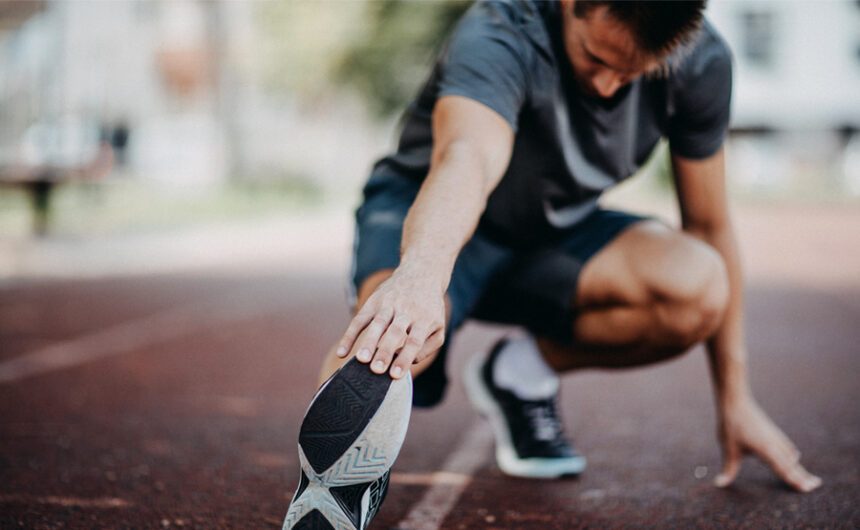What should you do when activity leaves your muscles so sore you can hardly move? It might not be what you want to hear, but—you move anyway!
“The best thing you can do for sore muscles is get up and move,” says UNC Health Wellness Services manager and certified personal trainer Kathy DeBlasio, MA.
Muscles that are sore from overuse while working out, doing yardwork, cleaning, playing or other physical activities will usually feel better in a day or two, she says.
There are ways to avoid much of the soreness, she says, but almost everybody gets sore sometimes.
“You might work out every day, but then it’s time to rake the leaves,” DeBlasio says. “You haven’t raked the leaves in a year, and you’re using different muscles or moving them differently. That can make you sore.”
How to Avoid Muscle Soreness
The best plan is to prevent muscle soreness in the first place. Here’s how to do it:
- Ease into your workout routine.
If you are starting an exercise regimen or getting back into it after a break, don’t overdo it. For strength training, start with light weights and limit the number of reps. Take it slow with cardio, too; let your heart rate increase gradually.
“That gives your body time to adjust to new stress,” DeBlasio says. “Slowly increase your workouts over time. A good rule of thumb is don’t increase your workout intensity or duration more than 10 percent per week.”
- Warm up first every time you exercise.
Get blood flowing to your muscles before your workout by starting with light cardio, such as walking or riding a stationary bike.
“Warming up your muscles creates a better connection between your brain and your body,” DeBlasio says. “That increased blood flow to your muscles and neuromuscular awareness decrease your risk of injury as you do more work.”
Include some dynamic stretching, such as lunges, side steps, straight-leg kicks and anything else that mimics the activities you’ll do during exercise. This gets your muscles ready.
- Eat for muscle health.
A balanced diet is powerful for many things, and the health of your muscles is no exception. Carbohydrates will give you energy, healthy fats enable nutrient absorption and help lubricate joints, and protein repairs microtears in muscles.
- Hydrate—and then hydrate some more.
Drinking plenty of water before, during and after workouts will keep your body hydrated, which is critical for overall health and muscle health in particular, DeBlasio says.
Exercise warms you up, and sweating helps cool you down. You need to replace that water. Staying hydrated helps your body maintain a normal temperature, lubricates and cushions joints, protects your spinal cord and other sensitive tissues, and helps your body get rid of wastes produced during exercise.
- Listen to your body.
Exercise can be challenging, but when you start to feel your muscles burning, it’s time to slow down or stop, DeBlasio says. “Your body is telling you that you’ve had enough.”
- Cool off after exercising.
Don’t abruptly stop your activity, whether you’re running, lifting, swimming or dancing. Slow your movements until your heart and breathing rates are only slightly elevated, then perform some static stretches. Stretch as far as the muscle will go and hold it for 15 to 20 seconds.
How to Feel Better When Your Muscles Are Sore
Of course, soreness is sometimes inevitable. Here are things you can do to ease the pain of muscle aches caused by overuse:
- Warm up your muscles and stretch.
Remember, if you have sore muscles, you want to keep moving. But do it carefully. Warm up the way you get ready for exercise—walk or march in place, for example. Then gently stretch.
“Warming the muscles up makes them more flexible,” DeBlasio says. “Hold each stretch with tension but not pain. Don’t bounce into a stretch. Be sure to hold it for at least 20 seconds to allow your muscles to relax into the stretch.”
Adding some mind-body techniques may help. “As you exhale, imagine you are releasing tension in that muscle,” she says.
- Drink water.
Just as water is important for regulating your body temperature and maintaining body function during exercise, it is also key in recovery. Good hydration helps your body flush out waste products that can contribute to soreness, such as lactic acid.
- Massage the muscles.
Massage helps work out tension in muscles. It increases blood flow and pushes out any fluid that has pooled in your muscles and joints. You can go to a massage therapist, or you can use a foam roller and slowly roll over areas of tension to help release tight muscles.
- Use heat or ice.
Applying either heat or ice may help disrupt the pain, DeBlasio says. “You can ice an injury for the first 24 to 48 hours to reduce swelling, then apply heat if swelling has subsided. Soaking in a warm bath with Epsom salts may feel good. Do whatever makes you feel better.”
You may want to apply a topical muscle pain cream that will make your skin feel cool, warm, numb or tingly. These ointments don’t absorb deep enough to affect your muscles, but they can interrupt pain signals from your nerves and provide temporary relief.
- Switch up your movement.
The day after you’ve overdone it, try a different exercise, such as walking, riding a bike or doing yoga.
“Don’t let sore muscles sideline you,” DeBlasio says. “Knowing that more movement will help you feel better is incentive to get up and move.”
If you feel sharp pain after an activity, you may have sprained a ligament or strained a muscle or tendon. If so, see your doctor.
If you have questions about exercise or pain, talk to your doctor. Need a doctor? Find one near you.

